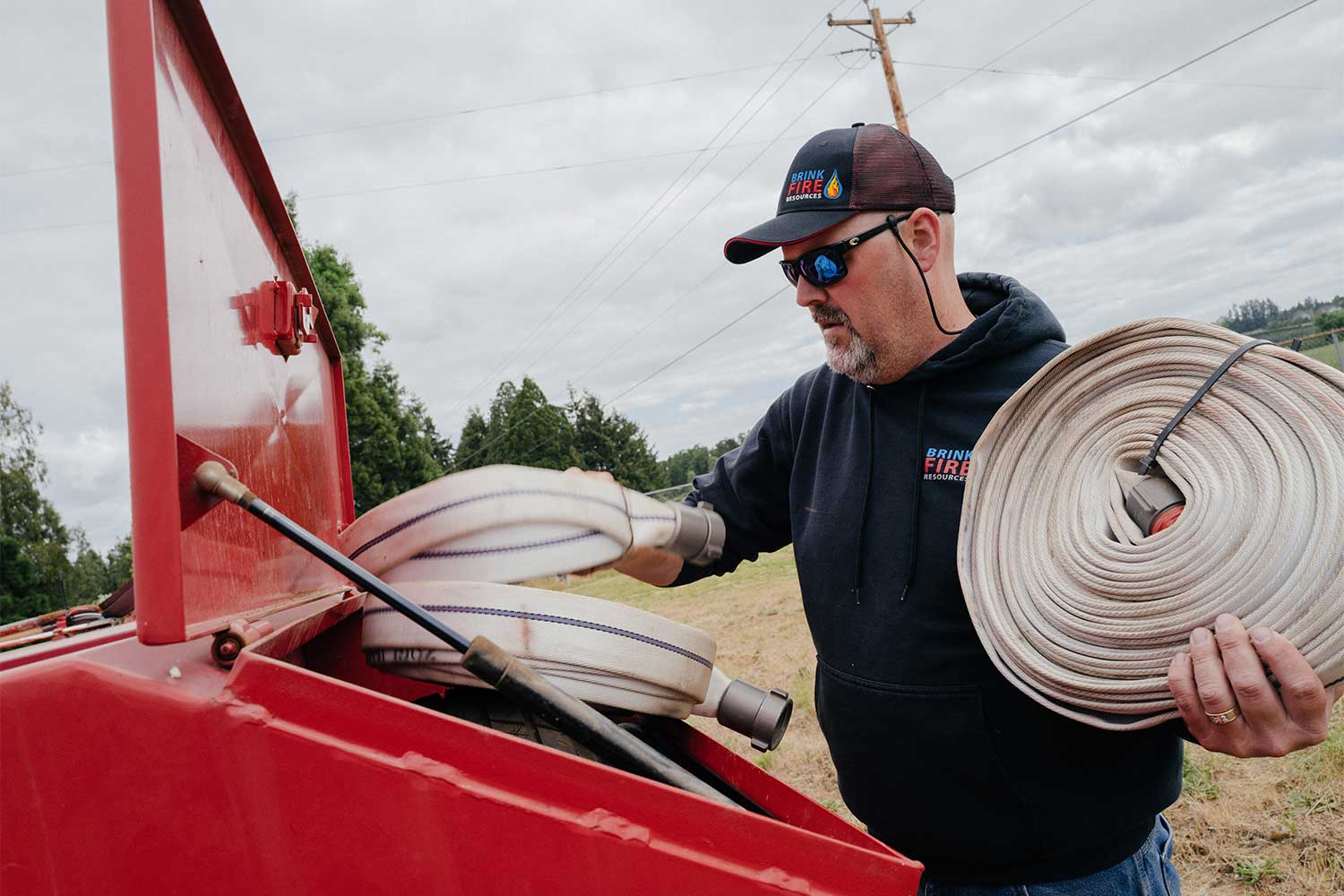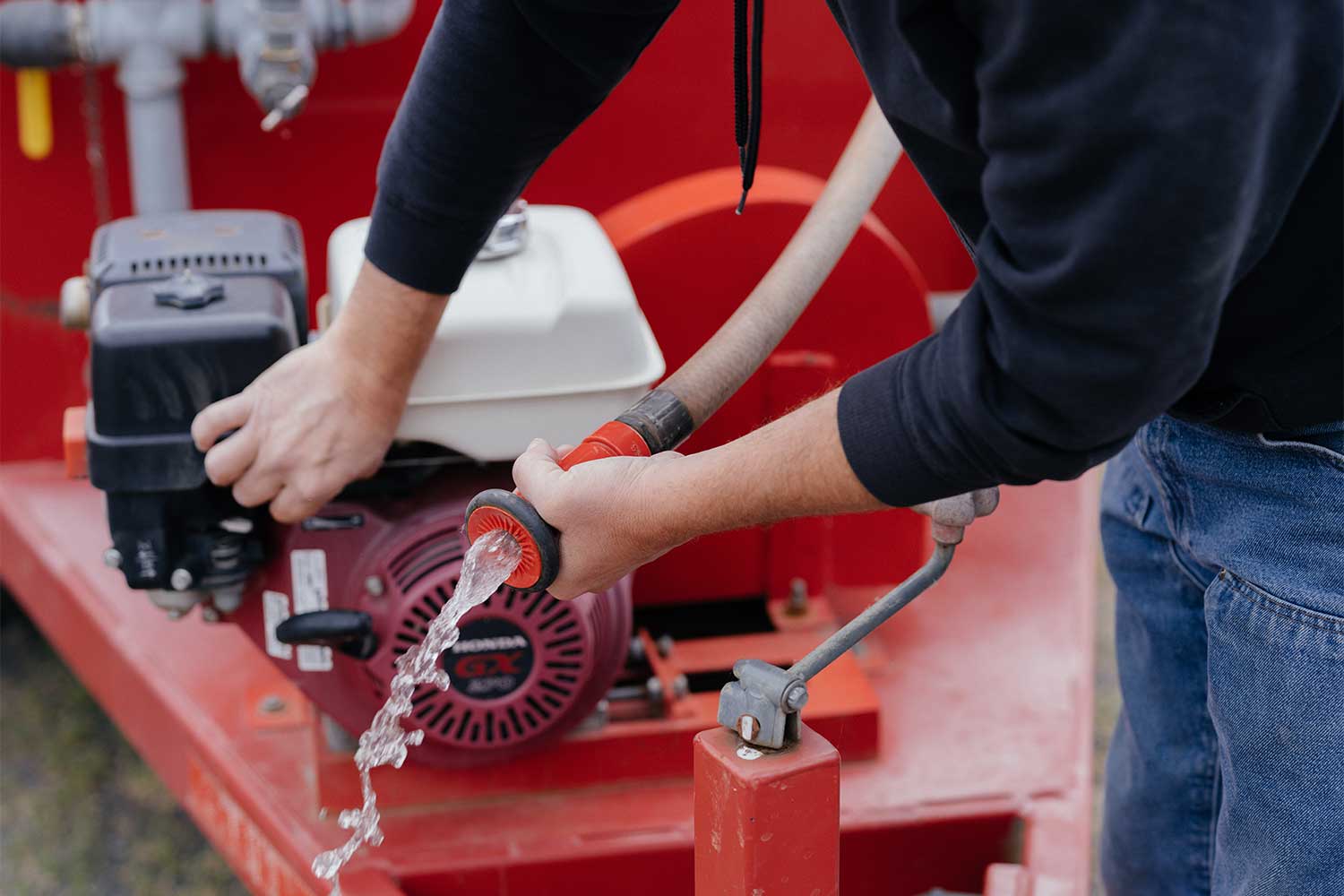Dave Brink has been president of Brink Fire Resources near Creswell for nearly 20 years. His business has routinely rented out fire suppression trailers, with water tanks, pumps and hoses, to people and companies. However, he could never have guessed what would happen after 2020.
Around Labor Day in September 2020, several massive fires hit Oregon. One of these was the Holiday Farm Fire, which virtually destroyed towns such as Blue River along Highway 126. According to a 2022 report by the Oregon Department of Transportation, “The 2020 Labor Day Wildfires have proven to be the most expensive disaster in Oregon’s history.” In October 2020, Oregon initially estimated a cost of $622 million and the U.S. Army Corps estimated $1.2 billion. As of June 30, 2022, the cost for the removal and cleanup of household hazardous waste, hazardous trees, ash and debris was $355 million, the report says.
According to the Oregon Department of Forestry, the fires burned 850,000 acres of forests, 11 people died and more than 4,000 homes were destroyed. Firefighting on the forest lands cost the department more than $130 million.
These fires caused a surge in business for Brink Fire Resources, as its fire units and trailers became more in demand than ever before. “When the Holiday Farm Fire started, we ran about 42 trailers,” Brink explains. “At this point, we’re up to roughly about 60.” These red trailers, which consist of 500-gallon and 600-gallon units, have a monthly rental of $1,000 or $1,150, depending on trailer model and year.
Since that disastrous fire, Brink’s trailers have been going out starting in the third week of April, and they are mostly gone by mid-June. Before 2020, customers would usually start renting the trailers in early June. People from all walks of life have been renting Brink’s trailers, ranging from ordinary people wanting to protect their homes to large companies and utilities such as EWEB.
The boom in business at Brink Fire Resources is just one example of the changes that have occurred in recent years. As the weather has become hotter and drier due to climate change, wildfires have started earlier and become larger than before. This has forced people to take more precautions to protect their property.
Since 2020, Oregonians are more aware of measures to protect their homes from wildfires, including fire mitigation actions. This has been reflected through increased education efforts. In addition, grants have been issued to help homeowners. However, obtaining insurance has been challenging for some.
Many people have formed local neighborhood and Firewise groups since the fires of September 2020. The National Fire Protection Association’s Firewise program helps neighbors organize and take action to protect their homes and community and reduce nearby wildfire risks. One of these, the Sunridge Firewise Community Committee near Lowell, was formed in August 2021 by Sunridge resident Kerry Augustyniak. When the Holiday Farm Fire hit the area, Augustyniak became concerned, and this helped motivate her to establish the group.
“I just felt like we just planted ourselves there and we were at the mercy of ourselves to figure out when to leave or not,” Augustyniak says. “So it’s been a big learning opportunity.”
The mission of the SFCC is to help people learn more ways to prevent wildfires from destroying their property. As a Firewise group, they are eligible for grants that can help them with that.
Enlarge

The group currently has about 15 members who regularly attend meetings for information on wildfire mitigation. Mark Bennett, for example, has taken measures such as putting in fire-resistant plants and keeping vegetation trimmed.
“This is all education through the Firewise program that I gained,” Bennett says.
The defensible space and other fuels reduction grants for some Firewise communities, including Greater Oakridge-Westfir, are made possible by Oregon Senate Bill 762, which was written after the 2020 Labor Day fires. The bill also allowed funding in other areas, such as fire education programs. However, the funding for some of these programs expires in June.
Sarah Altemus-Pope, executive director and facilitator for Southern Willamette Forest Collaborative, says people should not call to sign up for grants for now, as funding has run out. The programs, though, have been helpful for the community.
“We’re talking about how to become fire adapted communities, and now we’re working with landowners that want to do prescribed fire on their lands going forward,” Altemus-Pope says. Although the SB 762 funding has expired, she is optimistic that the Firewise programs will still be helpful.
Volunteer hours are also important, according to Altemus-Pope and Dustin Rymph, the SWFC’s outreach coordinator. Rymph says that the Oakridge and the Greater Oakridge-Westfir Firewise groups help neighbors get ready for fire season by removing leaves from gutters, mowing their lawns, and other assistance that can better protect homes from fire. They also provide education to help better prepare people.
“We have a Fire Safe Council, and that’s open to the public,” Rymph says.
The Lane County Firewise Incentive Program offers rural Lane County homeowners financial assistance to protect their homes against wildfires. The program is only eligible to Lane County residents living outside the Eugene-Springfield Urban Growth Boundary. “We provide information about wildfire mitigation things that they can do around their homes, within the first 100 feet or so — what the fire protection association calls the ‘home ignition zone,’” says Ben Zublin, land management technician for Lane County Firewise.
Firewise grants to homeowners can range anywhere from around $2,000 to $15,000, depending on the circumstances. These grants and education programs have been important to many rural Lane County homeowners.
April Klein, a resident of Dorena, does not have a Fire Protection District where she lives. Fire Protection Districts allow rural residents and communities to form a board and levy taxes to pay for fire protection. The lack of a district has frustrated her, as she and her neighbors do not get the same help that other communities receive. However, Lane County Firewise has helped her with implementing a defensible space on her property.
“Our grant is for getting up to a 100-foot firebreak,” Klein says. She and her husband initially received a letter from the county requiring a defensible space, making them nervous, as they were unsure how they would get the money to do this. The Firewise grant was instrumental in this, and even though the requirement was eventually removed, they are still going ahead with it.
The lack of a fire district is also pushing residents to establish one. Klein’s neighbor, Jennifer Ferraez, helped form the Row River Fire Response. She and other residents are making efforts to get it on the ballot in time for the May 2024 election.
Enlarge

“We’re needing the signatures this summer before September. We need a certain percentage of signatures in support for this,” Ferraez says. “So, we’re doing door to door canvassing.” In addition, they are holding various volunteer and community meetings.
The increasing wildfires have also made it harder for some people to buy insurance. According to Kenton Brine, president of NW Insurance Council, the insurance market is hardening, meaning that it is harder to find coverage and it is more expensive. One of these factors is the increasing risk of catastrophic wildfires leading to property damage. This June, a jury found that PacifiCorp, Oregon’s second largest electrical utility, owed $90 million in damages to just 17 plaintiffs who suffered losses in the 2020 Labor Day fires, which the jury found were caused by the utility’s negligence.
“What companies can do (and some are doing so) is adjust their ‘book of business,’ and in some cases reduce their overall exposure to risk of catastrophic loss due to wildfire,” Brine says in an email to Eugene Weekly. This includes developing or making changes to previously developed risk maps or risk scores.
“No insurer writing in Oregon has used, or had any plans to use, the Wildfire Risk Map developed by the state of Oregon last year,” Brine adds.The map created such controversy with rural landowners it was withdrawn. In addition, some insurers may take actions on a more regional basis if they believe the risk is too great in some areas. This includes increasing premiums on customers.
These insurance issues make fire education more important. Along with Firewise and neighborhood groups, the Office of the State Fire Marshal is raising awareness. Fire risk reduction specialists were formed as part of funding from SB 762.
“We’ve been hosting quite a few webinars,” says Kyle Reed, a fire risk reduction specialist who covers Coos, Curry, Douglas and Lane counties. “We’ve had some pretty good attendance on those webinars.” These webinars, in addition to several in-person sessions, focus on how to implement wildfire mitigation measures.
With wildfires on the rise, the Oregon Department of Forestry is also taking steps to raise awareness.
“We’ve increased our prevention efforts in the last five to 10 years, especially here in the district,” says John Deegan, a protection unit forester for the Oregon Department of Forestry who covers western Lane County. “But what we do hasn’t really changed.” The Oregon Department of Forestry has posted prevention signs, hosted local events, and gone to outdoor schools to talk to students about firefighting and fire.
Individual fire districts are also doing their part to make residents aware of these wildfires by giving presentations and holding meetings.
“We want folks to be ready for anything at any time,” says Darren Bucich, fire chief of McKenzie Fire & Rescue. In addition, they also work with the fire marshal’s office on grant opportunities.
Bucich knows firsthand how destructive wildfires are. The Holiday Farm Fire burned for over a month. In his district, the town of Blue River was essentially destroyed, and other towns were damaged. Many homes and buildings were destroyed.
Bucich advises people that in addition to coming to these informational events, they should do their own research.
“The literature is out there,” Bucich says. “We just have to get people to follow it.”
Dave Brink, the president of Brink Fire Resources, is concerned that wildfires could eventually strike close to Eugene and Springfield. In 2022 alone, 128,106 acres burned in Willamette National Forest. This is a major increase from years past, with just 54 acres burning in 2019. The rebuilding costs have been staggering, with the U.S. Department of Housing awarding $422 million in grant funding in response to the 2020 Labor Day Fires.
“I don’t say it’s not gonna happen, it’s when it’s gonna happen at this point,” Brink says.
